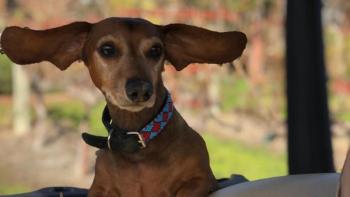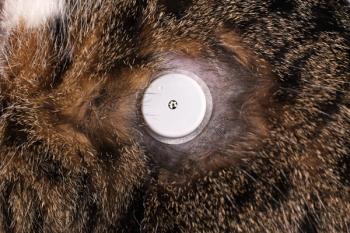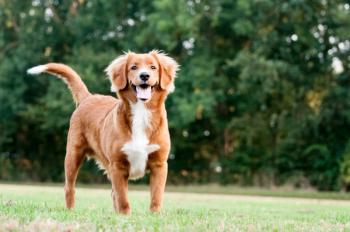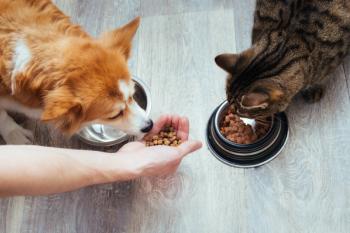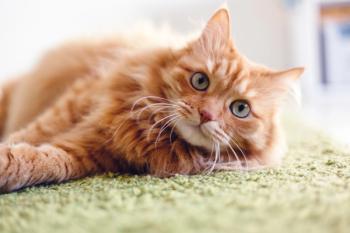
Just Ask the Expert: A tough feline diabetes case
Q: We have an approximately 15-yr-old MN DSH clinic cat who has diabetes. I "rescued" him from his owners who were no longer giving him insulin or keeping him on Purina DM.
Dr. Bruyette welcomes endocrinology questions from veterinarians and technicians.
To ask your question, e-mail:
With the subject line: Endocrinology Questions
Q: We have an approximately 15-yr-old MN DSH clinic cat who has diabetes. I "rescued" him from his owners who were no longer giving him insulin or keeping him on Purina DM. He has been on glargine b.i.d. up to 7 units. His best control was on 5U b.i.d., and his glucose levels were 200mg/dl all day. On 7U b.i.d. his levels were 300. I suspected Somogyi overswing so I cut him back to 4U b.i.d. and increased him to 5U after his glucose levels went from 300 pre-insulin to 560 in 9 hours. He eats a controlled amount of Hill's m/d dry and DM canned. His weight has gone from 11.5 lb in January (when owner wasn't treating) to 18 lb!
I'd appreciate any advice please. I think that with such high glucose levels he would not be gaining weight. His latest curve on July 7 started at 244 and ended in 12 hours at 400. There seems to be no nadir during the day. Of course he's PU/PD. Should I just use fructosamine to monitor him?
Kind regards,
Nancy Maxeiner, DVM
A: First of all, congratulations on having the poster child of feline diabetes (old, fat and male). I think this case illustrates the common challenges seen with managing cats with diabetes.
At his current body weight of 18 lb it looks like he is receiving about 0.6 units/kg of glargine b.i.d. This is slightly higher than we see in most cats where the average dose is 0.25 – 0.5 units/kg b.i.d.
Since glargine is a basal insulin you really will not see a lot of swing in the blood glucose levels over the day, as there are not going to be large swings in his serum insulin levels throughout the day. This is not the case with other insulin preparations such as NPH, PZI, or Lente where we tend to see peaks and troughs and where a combination of 12-hour blood glucose curves and fructosamine levels were needed to address insulin dose in animals with poor glucose control.
Based on the glucose curve obtained on July 7 in conjunction with the persistent clinical signs of polyuria and polydipsia I would suggest the following:
1) Raise the dose to 6 units b.i.d.
2) After 7 days obtain a pre meal and pre-insulin blood glucose level as well as a 4-hour post-meal, post-insulin blood glucose sample.
I would then adjust the insulin dose as follows. These recommendations for cats are based on our experience as well as on the data generated by Dr. Jacquie Rand at the University of Queensland.
a. If the preinsulin blood glucose concentration is> 360 mg/dl and/or the 4-hour blood glucose concentration is> 180 mg/dl, the dose of insulin is increased by 0.5 to 1 unit b.i.d.
b. If the preinsulin blood glucose concentration is 270 to 360 mg/dl and/or the 4-hour blood glucose concentration is 90 - 180 mg/dl, the dose of insulin is maintained.
c. If the preinsulin blood glucose concentration is 190 - 270 mg/dl and/or the 4-hour blood glucose concentration is 54 - 90 mg/dl, use the 4-hour sample result, clinical signs, and the next preinsulin glucose concentration to determine if the dose is decreased or maintained.
d. If the preinsulin blood glucose concentration is <180 mg/dl and/or the 4-hour blood glucose concentration is <54 mg/dl, the dose of insulin is decreased by 0.5 to 1 unit b.i.d. If the total insulin dose is already 0.5 – 1 unit b.i.d., stop the insulin and check for diabetic remission by measuring the 4-hour post meal blood glucose concentration in 1 and 4 weeks.
The other issue is the weight. Make sure you are following the manufacturer's feeding recommendation and that you are feeding the amount of calories intended for his ideal body weight. Some cats will gain weight on the high protein/low carbohydrate diets if they are not fed the appropriate amount of calories since they are very palatable and calorically dense. Keep us posted and let us know how things go from here.
Dave Bruyette, DVM, DACVIM
Medical Director
VCA West Los Angeles Animal Hospital
West Los Angeles, Calif.
The intent of Just Ask the Expert is to address non-urgent medical questions and to share this information through the Web site with other practitioners. The recommendations are for informational purposes only. It is each clinician's responsibility to carefully weigh these recommendations and determine the right course of action for each patient. Please verify any drug dosages discussed. Questions may be edited for style and length.
Newsletter
From exam room tips to practice management insights, get trusted veterinary news delivered straight to your inbox—subscribe to dvm360.


